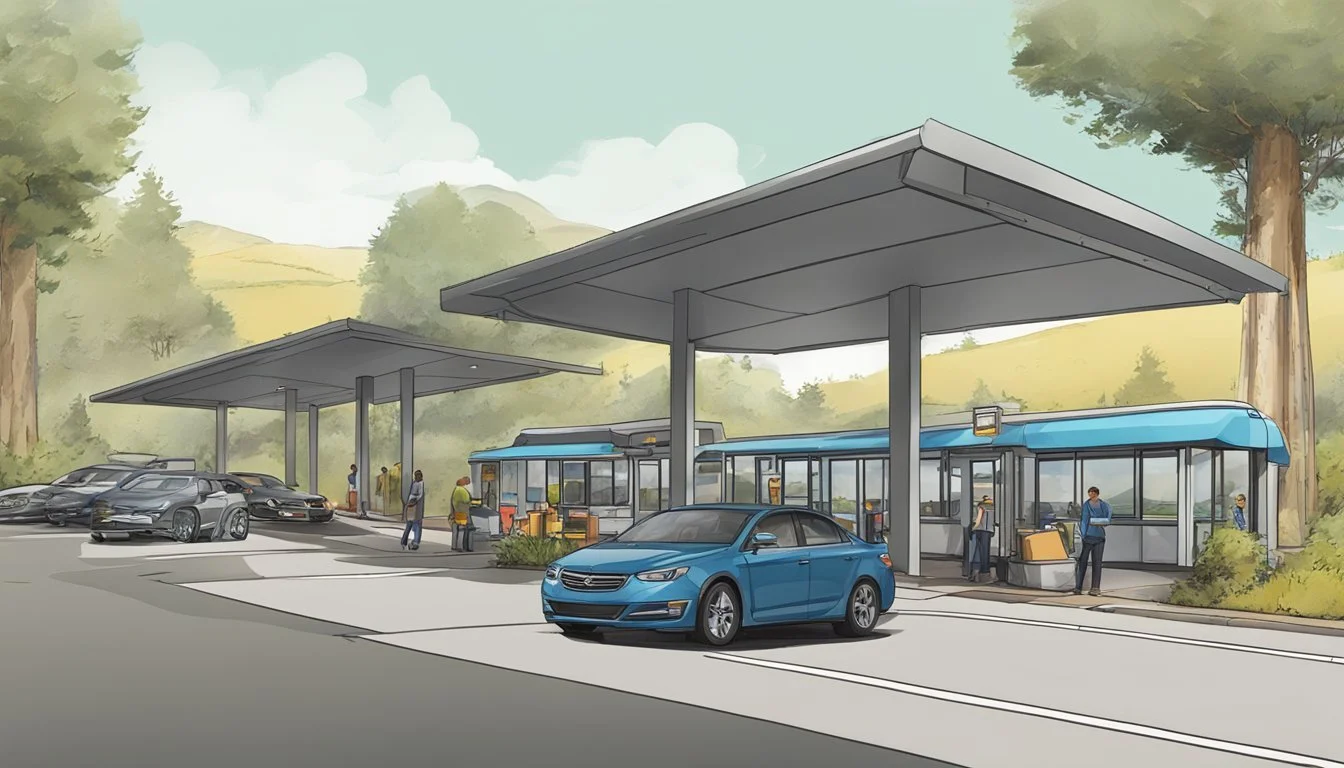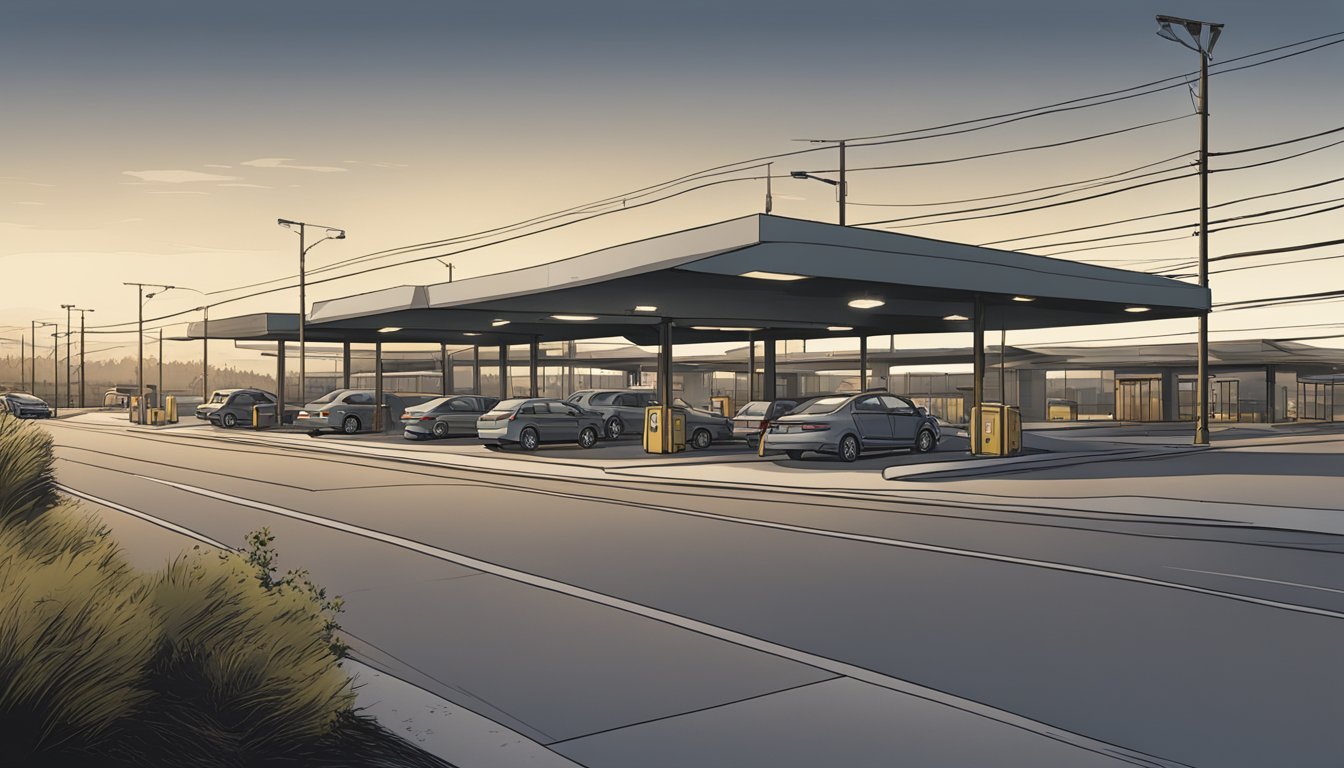Randall Woodfield: 7 I-5 Rest Stops
Key Locations in the Notorious Killer's Crime Spree
Randall Woodfield, known as the I-5 Killer, left a trail of terror along the Interstate 5 corridor in the early 1980s. His crime spree spanned Washington, Oregon, and California, targeting victims at various locations along the highway.
Rest stops played a significant role in Woodfield's criminal activities, serving as both hunting grounds and escape routes. These seemingly innocuous places became sinister locations where the former football player turned serial killer carried out his heinous acts. Understanding the connection between these rest stops and Woodfield's crimes provides insight into the methods of this notorious criminal.
1) Salem Rest Area
The Salem Rest Area, located along Interstate 5 in Oregon, played a significant role in Randall Woodfield's criminal activities. This rest stop, situated near the state capital, provided Woodfield with opportunities to target unsuspecting victims.
As a native of Salem, Woodfield was familiar with the area and its surroundings. He often used the rest area as a hunting ground, taking advantage of travelers who stopped for a break during their journeys.
The Salem Rest Area's location made it an ideal spot for Woodfield to blend in with other motorists. Its proximity to the city also allowed him to quickly escape after committing his crimes.
Law enforcement agencies later identified this rest stop as one of the key locations in Woodfield's pattern of attacks. The site became an important focus of their investigation into the I-5 Killer's activities.
Today, the Salem Rest Area serves as a somber reminder of the darker aspects of Interstate 5's history. It stands as a testament to the importance of vigilance and safety for travelers using highway facilities.
2) Wilsonville Rest Stop
The Wilsonville Rest Stop, located at mile marker 281 on Interstate 5 in Oregon, played a significant role in Randall Woodfield's criminal activities. This rest area, situated near the city of Wilsonville, provided both northbound and southbound access for travelers.
Woodfield, known as the I-5 Killer, frequented rest stops along the interstate during his crime spree in the early 1980s. The Wilsonville Rest Stop's location made it a convenient target for his predatory behavior.
Law enforcement investigators believe Woodfield may have used this rest area to scout for potential victims. Its proximity to Portland, where some of his known crimes occurred, made it a strategic location for his activities.
The rest stop's layout, with separate facilities for northbound and southbound travelers, potentially allowed Woodfield to observe and select targets more discreetly. This dual-access design is common along I-5 in Oregon.
While specific details of crimes committed at this location are limited, the Wilsonville Rest Stop remains an important point of interest in the investigation of Woodfield's activities along the I-5 corridor.
3) Grants Pass Rest Area
The Grants Pass Rest Area along Interstate 5 in southern Oregon became a notable location in Randall Woodfield's series of crimes. This rest stop, situated near mile marker 61, provided Woodfield with opportunities to target unsuspecting travelers.
Woodfield frequented this area during his crime spree in the early 1980s. The isolated nature of rest stops made them ideal hunting grounds for predators like Woodfield, allowing him to observe potential victims and plan his attacks.
Law enforcement investigators believe Woodfield may have committed several assaults and at least one murder linked to this rest area. However, due to the transient nature of rest stop visitors, connecting specific crimes to this location proved challenging for police.
The Grants Pass Rest Area serves as a chilling reminder of how seemingly innocuous public spaces can become scenes of criminal activity. Its association with the I-5 Killer case led to increased security measures at rest stops along the interstate corridor.
4) Woodburn Interchange
The Woodburn Interchange, located along Interstate 5 in Oregon, gained notoriety during Randall Woodfield's crime spree in the early 1980s. This busy intersection served as a crucial connection point between I-5 and Oregon Route 214.
Woodfield, known as the I-5 Killer, often targeted areas near highway exits and rest stops. The Woodburn Interchange provided easy access to potential victims and quick escape routes.
Law enforcement agencies closely monitored this area during their investigation into the I-5 Killer's activities. The interchange's proximity to both populated areas and more isolated locations made it a point of interest for detectives.
While specific crimes at this location remain unconfirmed, the Woodburn Interchange exemplifies the type of infrastructure Woodfield exploited during his criminal activities. Its role in the investigation highlights the challenges faced by law enforcement in tracking a mobile predator along the I-5 corridor.
5) Albany Rest Stop
The Albany Rest Stop along Interstate 5 in Oregon became a significant location in Randall Woodfield's crime spree. This rest area, situated between Portland and Eugene, provided Woodfield with opportunities to target unsuspecting victims.
In late 1980, Woodfield used the Albany Rest Stop as a hunting ground. He would park his vehicle and wait for potential targets to arrive. The isolated nature of rest stops made them ideal locations for Woodfield to carry out his crimes.
At this particular rest area, Woodfield attacked and sexually assaulted at least one woman. His modus operandi typically involved approaching victims with a gun or knife, forcing them into secluded areas, and then assaulting them.
The Albany Rest Stop incident contributed to the growing fear along the I-5 corridor during Woodfield's active period. Law enforcement increased patrols at rest stops in response to these attacks, but Woodfield managed to evade capture for several months.
This location serves as a chilling reminder of the vulnerability of travelers and the importance of safety measures at highway rest areas. The events at the Albany Rest Stop played a role in shaping the investigation and eventual capture of the I-5 Killer.
6) Central Point Rest Area
The Central Point Rest Area along Interstate 5 in Oregon became a notable location in Randall Woodfield's crime spree. Situated just north of Medford, this rest stop provided Woodfield with opportunities to target unsuspecting travelers.
Woodfield frequented this area during his travels up and down the I-5 corridor. The rest area's location offered easy access for approaching potential victims and a quick escape route.
Law enforcement investigators identified the Central Point Rest Area as a site where Woodfield may have committed assaults or made contact with victims. However, specific details of crimes at this location remain limited in public records.
The rest area's role in Woodfield's series of crimes highlights how seemingly innocuous public spaces can become dangerous when exploited by predators. It serves as a reminder of the importance of situational awareness, even in commonplace settings.
7) Santiam River Rest Area
The Santiam River Rest Area is located along Interstate 5 in Oregon, approximately 8 miles north of Albany. This northbound rest stop is situated around mile marker 241 on I-5.
The facility offers a range of amenities for travelers, including restrooms, picnic tables, and pet exercise areas. Vending machines are available for those seeking snacks or beverages during their journey.
Like other rest areas along I-5, the Santiam River location provides a convenient stopping point for motorists. Its proximity to Albany and placement along a major interstate corridor made it a potential site of interest in the investigation of the I-5 Killer's activities.
Law enforcement agencies often scrutinize rest stops during serial crime investigations due to their isolated nature and transient populations. The Santiam River Rest Area's position along Randall Woodfield's known travel routes likely drew attention from investigators working to piece together his movements.
While specific details of Woodfield's activities at this particular rest area remain unclear, its inclusion in discussions of the I-5 Killer case highlights the role these facilities played in the broader investigation.
Background on Randall Woodfield
Randall Woodfield's transformation from a promising athlete to the notorious I-5 Killer shocked many. His middle-class upbringing and early potential contrasted sharply with his later criminal activities.
Early Life and Personality
Randall Brent Woodfield was born on December 26, 1950, in Salem, Oregon. He grew up in a respected, upper-middle-class family in Otter Rock. His father worked as an executive at Pacific Northwest Bell, while his mother was a homemaker.
Woodfield had two older sisters who went on to successful careers in medicine and law. As a young man, he showed athletic promise and maintained a seemingly normal facade.
Despite his outward appearance, Woodfield harbored dark tendencies that would later come to light.
Timeline of Criminal Activity
Woodfield's criminal activities escalated over time, culminating in his infamous I-5 killing spree. His crimes included:
Early 1970s: Arrested for minor offenses and indecent exposure
1975: Drafted by the Green Bay Packers, but cut from the team
Late 1970s: Engaged in robbery and sexual assault
1980-1981: Committed a series of murders along Interstate 5
On January 18, 1981, Woodfield killed Shari Hull in a Keizer office building. This crime led to his eventual capture and conviction.
Woodfield's five-month crime spree along I-5 terrorized communities. He targeted various victims, often attacking in office buildings and other locations near the interstate.
Impact and Aftermath
Randall Woodfield's crimes left a lasting impact on communities along Interstate 5. Law enforcement agencies and the public grappled with the aftermath of his violent spree.
Law Enforcement Response
Police departments across multiple states coordinated efforts to track down the I-5 Killer. Detective Dave Kominek of Marion County, Oregon played a crucial role in the investigation. He identified Woodfield as a suspect early on, leading to his eventual capture.
Improved communication between jurisdictions became a priority. Law enforcement agencies implemented new protocols for sharing information about similar crimes across state lines. This case highlighted the need for better interstate cooperation in tracking serial offenders.
Forensic techniques also advanced as a result of the investigation. DNA analysis, though still in its infancy, gained prominence as a tool for linking crimes and identifying suspects.
Public and Media Reaction
The I-5 Killer case generated intense media coverage. News outlets along the West Coast reported extensively on the crimes, creating a climate of fear among local communities.
Public safety concerns surged, particularly for women traveling alone. Many people altered their routines and became more cautious at rest stops and isolated areas near I-5.
The revelation of Woodfield's past as a former NFL draft pick shocked the public. This aspect of his background garnered significant attention and sparked discussions about the potential for seemingly ordinary individuals to commit heinous acts.
Support groups formed for victims' families, providing a platform for healing and advocacy. These organizations pushed for improved victim services and changes in the criminal justice system.










